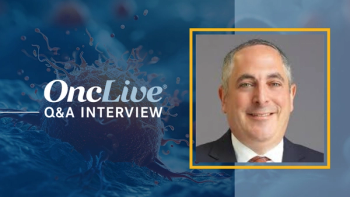
Long-Term Follow-up Sustains Sonidegib Benefit in Basal Cell Carcinoma
The hedgehog inhibitor sonidegib (Odomzo) showed continued antitumor activity with no new safety concerns in patients with advanced basal cell carcinoma.
Reinhard Dummer, MD
The hedgehog inhibitor sonidegib (Odomzo) showed continued antitumor activity with no new safety concerns in patients with advanced basal cell carcinoma (BCC), according to a 30-month follow-up of the pivotal BOLT trial presented at the 2016 ASCO Annual Meeting.
At the 30-month follow-up, patients with locally advanced BCC had an overall response rate (ORR) of 56% and 45% at the 2 study doses of 200 mg and 800 mg of sonidegib, respectively. Among patients with metastatic BCC, the ORR rates at the lower and higher doses were 8% and 17%, respectively.
“These data support the use of sonidegib at 200 mg (FDA-approved dose) for the treatment of patients with locally advanced basal cell carcinoma and metastatic basal cell carcinoma according to local treatment guidelines,” lead author Reinhard Dummer, MD, professor, Department of Dermatology, University of Zurich Hospital, and coauthors wrote in their ASCO poster conclusion.
The BOLT trial was an international, double-blind, noncomparative study that randomized 230 patients with metastatic basal cell carcinoma or locally advanced BCC not amenable to local therapy in a 2:1 ratio to either 800 mg (n = 151) or 200 mg (n = 79) of sonidegib until disease progression or unacceptable toxicity.
Patient demographics were well balanced between the 2 treatment arms. The median patient age across the study was approximately 66 years. In the 200-mg arm, patients had a ECOG performance status of 0 (63%), 1 (24%), 2 (10%), or unknown (3%). In the 800-mg arm, the corresponding rates were 63%, 29%, 7%, and 1%, respectively. Seventy-five percent of patients in the 200-mg cohort and 83% of patients in the 800-mg cohort had received prior surgery. The rates of prior radiotherapy were 24% and 32%, respectively.
More than half of the patients in each arm with locally advanced disease at baseline had aggressive histology (eg, micronodular, infiltrative). Eighteen percent of patients in the low-dose arm and 15% of patients in the high-dose arm had disease metastases. The sites of metastases for patients across the study included lung (71% in the in the 200-mg arm vs 52% in the 800-mg arm), lymph nodes (7% vs 30%), bone (14% vs 22%), and other (21% vs 30%).
The primary outcome measure was ORR. Secondary endpoints included duration of response (DOR), complete response (CR), progression-free survival (PFS), overall survival (OS), and safety. The data cutoff for the 30-month analysis was July 10, 2015, and the median follow-up was 38.2 months.
At 30-months’ follow-up, 8% of patients in in the 200-mg cohort and 6% of patients in the 800-mg cohort were still receiving treatment. The primary reasons for treatment discontinuation in the lower-dose arm were adverse event (AE; 29%), progressive disease (37%), patient decision (10%), physician decision (13%), loss to follow-up (3%), and death (1%). The corresponding rates in the higher-dose arm were 38%, 15%, 22%, 9%, 3%, and 3% respectively.
The ORR across all patients receiving the 200-mg dose was 48% (95% CI, 37-60), comprising a 56% ORR (95% CI, 43-68) in patients with locally advanced BCC (n = 66) and an 8% ORR (95% CI, 0.2-36) in patients with metastatic BCC (n = 13). In the locally advanced group, the CR rate was 5%, the partial response (PR) rate was 52%, and the stable disease (SD) rate was 35%. The disease control rate was 91% and the rate of progressive disease was 2%. Median DOR was 26.1 months, the median PFS was 22.1 months, and the 2-year OS rate was 93% (95% CI, 80-98).
In patients with metastatic BCC treated with the 200-mg dose, there were no CRs, the PR rate was 8%, the SD rate 85%, and rate of progressive disease was 0. The disease control rate was 92%, the median DOR was 24 months, the median PFS was 13.1 months (95% CI, 5.6-33.1), ad the 2-year OS rate was 69% (95% CI, 31-89).
The ORR across all patients receiving the 800-mg dose was 41% (95% CI, 33-49), comprising a 45% ORR (95% CI, 36.5-54) in patients with locally advanced BCC (n = 128) and a 17% ORR (95% CI, 5-39) in patients with metastatic BCC (n = 23). In the locally advanced group the CR rate was 2%, the PR rate was 44%, the SD rate was 37%, and the progressive disease rate was 1%. The DOR rate was 82%, the median DOR was 23.7 months (95% CI, 12.2-29.6), the median PFS was 22.0 months (95% CI, 16.7-33.4), and the 2-year OS rate was 91% (95% CI, 83-95).
In patients with metastatic BCC who received the 800-mg dose, there were no CRs, the PR rate was 17%, the SD rate was 74%, and the rate of progressive disease was 4%. The disease control rate was 91%, the median DOR was not reached, the median PFS was 11.1 months (95% CI, 7.3-16.6), and the 2-year OS rate was 69% (95% CI, 43-85).
All patients receiving the 800-mg dose and 97.5% of patients receiving the 200-mg dose experienced at least 1 AE. As expected, AE rates were lower with the 200-mg dose.
The rates of grade 3/4 AEs (43% vs 64%) and serious AEs (20% vs 39%) were lower with the 200-mg versus the 800-mg dose. Dose interruptions or reductions were required for 43% of the 200-mg cohort versus 67% of the 800-mg cohort. The rate of AEs leading to discontinuation was 30% versus 40%, respectively. One patient died in the 200-mg cohort and 7 patients died in the 800-mg cohort; however, none of the deaths were determined to be related to sonidegib.
Among all 79 patients who received 200-mg of sonidegib, the most common all-grade AEs were muscle spasms (54%), alopecia (49%), dysgeusia (44%), nausea (39%), diarrhea (32%), and weight decrease (30%). The most common grade 3/4 AEs were CK increase (7%), weight decrease (5%), muscle spasms (3%).
In the cohort of 150 patients treated with 800 mg of sonidegib, the most common all-grade AEs were muscle spasms (69%), dysgeusia (60%), alopecia (58%), nausea (47%), weight decrease (43%), CK increase (37%), and fatigue (37%). The most common grade 3/4 AEs were CK increase (13%), weight decrease (6%), muscle spasms (5%), appetite decrease (4%), and nausea (3%).
Based on an earlier analysis of the BOLT trial, the FDA approved sonidegib in July 2015 as a treatment for patients with locally advanced BCC that has recurred following surgery or radiation, or for patients who are not eligible for those treatments.
Dummer R, Migden MR, Guminski A, et al. Efficacy and safety of sonidegib in patients (pts) with locally advanced (la) or metastatic (m) basal cell carcinoma (BCC): BOLT 30-month analysis. J Clin Oncol 34, 2016 (suppl; abstr 9538).

























































































